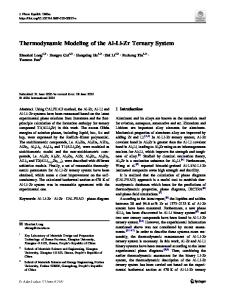Thermodynamic consistency of the ternary functions
- PDF / 611,090 Bytes
- 9 Pages / 597.28 x 785 pts Page_size
- 71 Downloads / 310 Views
A ternary thermodynamic function has been developed based on statistico-thermodynamic considerations, with a particular emphasis on the higher-order terms indicating the effects of truncation at the various stages of the treatment. Although the truncation of a series involved in the equation introduces inconsistency, the latter may be removed by imposing various thermodynamic boundary conditions. These conditions are discussed in the paper. The present equation with higher-order terms shows that the c~ function of a component reduces to a quadratic function of composition at constant compositional paths involving the other two components in the system. The form of the function has been found to be representative of various experimental observations.
I.
INTRODUCTION
V A R I O U S functions in the truncated form are frequently found to be useful in developing analytical equations in thermodynamics. Based on Guggenheim's [~1 quasi-chemical approach, Lupis and Elliott I21 have deduced a thermodynamic function for multicomponent systems. The final solution of the equation, however, is dependent on the truncation of the Taylor series involved in the treatment and applicable to the dilute solution range. The application of the latter series has also been extensively used in arriving at the dilute solution interactions in multicomponent systems, t31 The resulting function derived from such expansion is considered to be mathematically exact, if it is not truncated, t41 However, the series truncations at various stages are often necessary to develop suitable analytical functions. Apart from the Taylor series, truncations are also encountered in thermodynamics with respect to exponential, logarithmic, and quadratic functions. Based on statistico-thermodynamic considerations, the present work shows that the ternary regular solution is a truncated form of a function in a manner somewhat different from that of Lupis and Elliott. i2] The present communication also reveals that the integral free energy function consists of higher-order terms which are significantly different from those developed by Lupis and ElliottJ 21 It has been shown that the latter function cannot be extrapolated beyond the dilute solution range because of the effect of truncation. The purpose of this paper is to further illustrate the fact that truncation limits thermodynamic consistency, unless the integral function is subjected to the terminal conditions and ideality conditions for each of the partials in the system. These conditions are discussed in detail in the paper, along with the development of the function, with an emphasis on the higher-order terms. II.
STATISTICO-THERMODYNAMIC CONSIDERATIONS
The quasi-chemical model of solution, as already mentioned, was introduced by Guggenheim c~1for binary
systems. The quasi-chemical approximation is based on a lattice model of which the main assumptions are (1) The motion of an atom is confined to its oscillations about an equilibrium position. (2) Only the configurational partition function of the solut
Data Loading...











